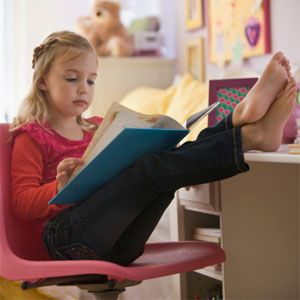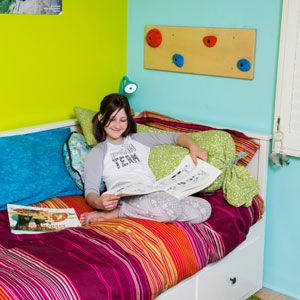
Creating an ideal study space for your child can foster good learning habits and academic success. A well-designed area can significantly improve focus, productivity, and overall enjoyment of study time. Whether you’re working with a dedicated room or a small nook, these design tips will help you craft the perfect study space for your child. From choosing the right location to personalizing the area, we’ll cover everything you need to know to create an environment that encourages learning and growth.
Understanding the Importance of a Dedicated Study Area
A designated study space plays a vital role in a child’s academic development. It provides a consistent environment for learning and helps establish a routine. Eileen Kennedy-Moore, Ph.D., a psychologist, mom of four, and coauthor of Smart Parenting for Smart Kids, explains, “A well-stocked, designated area means your child won’t have to waste time hunting for supplies or shuffling things around to find a place to work.” This efficiency allows your child to focus on their studies rather than getting distracted by disorganization or the need to constantly relocate. Moreover, having a dedicated space can signal the brain that it’s time to concentrate, thus improving your child’s ability to focus and retain information.
Choosing the Ideal Location for Your Child’s Workspace
Selecting the right location for your child’s study space is crucial for minimizing distractions and maximizing productivity. Consider factors such as noise levels, traffic flow in the house, and your child’s age when deciding on the perfect spot.
Considering Age-Appropriate Spaces
For younger children, particularly those in kindergarten through third grade, working in a public space is often more beneficial than studying alone in a bedroom. Timothy Davis, Ph.D., a child and family psychologist, advises, “Younger kids generally need more support during homework time, so a spot in the kitchen or home office means you can be on hand to answer questions and offer encouragement.” As children grow older, they may benefit from a more private study area that allows for greater independence and concentration. Ensure that the chosen location also provides enough space for younger children to spread out their materials without feeling cramped.
Balancing Privacy and Supervision
When setting up a study space, it’s important to strike a balance between privacy and supervision. For older children, a desk in their bedroom or a quiet corner of the house can provide the necessary focus. However, ensure that the space is still accessible for occasional check-ins. For younger children, consider a location where you can easily monitor their progress without hovering, such as a designated area in the living room or a corner of the kitchen. Additionally, ensure there are minimal distractions in the surroundings, such as loud televisions or high-traffic areas that can interrupt study sessions.
Essential Furniture for a Productive Study Space
The right furniture can significantly improve your child’s comfort and productivity during study sessions. When selecting pieces for the study area, focus on ergonomics and functionality.
Selecting the Right Desk
Choose a desk that is appropriate for your child’s size and provides ample workspace. Lori Woodring, Ph.D., a child psychologist and mom of four, suggests, “Place this piece of furniture in a spot that gets good light but also isn’t in front of the door or overlooking the backyard, which can lead to distraction.” Instead, position the desk against a wall, allowing your child to glance up at important papers and reminders on a calendar or dry-erase board hanging nearby. It’s also helpful to select a desk with drawers or compartments, enabling your child to store their study materials within arm’s reach.
Choosing Comfortable and Supportive Seating
Invest in a chair that provides proper support for your child’s back and promotes good posture. Adjustable chairs are ideal, as they can grow with your child. Ensure that when seated, your child’s feet can comfortably touch the ground, and their arms can rest on the desk at a 90-degree angle. Ergonomic chairs that provide lumbar support can help prevent back pain and ensure long-term comfort. Explore chairs with cushions or padding to make the seating experience more pleasant, especially during long study sessions.
Optimizing Lighting for Better Focus
Proper lighting is essential for reducing eye strain and maintaining focus during study sessions. A combination of natural and artificial light can create an ideal learning environment.
Natural Light Solutions
When possible, position the study area near a window to take advantage of natural light. However, be mindful of potential distractions from outside. If the view is too enticing, consider using sheer curtains to filter light while minimizing visual distractions. Natural light has been shown to improve mood and alertness, making it an ideal addition to a study space. Also, consider the orientation of the window to ensure that the sunlight does not create glare on screens or writing surfaces.
Task Lighting Options
In addition to natural light, task lighting is crucial for focused work. Deborah Gilboa, M.D., and a parenting and youth development expert, notes, “This light, along with any natural light from the window, should be enough illumination for your child to stay alert and focused.” Consider a desk lamp with adjustable brightness or pendant lights to provide adequate illumination for reading and writing tasks. LED lights are a great option for task lighting as they’re energy-efficient and provide bright, focused light. Additionally, installing dimmable lights can help adjust the brightness according to different times of the day or specific tasks.

Organizing Supplies and Materials
A well-organized study space can significantly improve efficiency and reduce stress. Consider systems that make it easy for your child to find and store their materials.
Implementing an Effective Storage System
Provide a variety of storage solutions to accommodate different types of supplies. Use cups or containers for pens, pencils, and markers, and designate folders or files for papers and assignments. Kennedy-Moore suggests, “Many kids also benefit from having a single ‘Turn It In’ folder where they can put anything that needs delivering to the teacher the next day. ” For older students, consider a filing system or cabinet to store completed work and returned assignments. Ensuring that supplies are labeled and categorized can make it easier for children to locate what they need quickly.
Creating a Clutter-Free Environment
Regularly decluttering the study space is essential for maintaining focus. Encourage your child to spend a few minutes at the end of each study session putting things away. This habit not only keeps the area tidy but also teaches responsibility. Reserve a shelf, windowsill, or cubby for your child’s personal items to keep the immediate study area free from distractions. Establishing a weekly or monthly cleanup routine can help maintain the organization and prevent the accumulation of unnecessary items.
Incorporating Technology Wisely
While technology can be a valuable learning tool, it’s important to manage its use to prevent distractions and promote healthy study habits.
Setting Up a Computer Station
If your child needs a computer for schoolwork, set up a dedicated station within the study area. Ensure that the computer is positioned at the correct height and distance for comfortable use. Consider using parental controls or productivity apps to limit access to distracting websites during study time. Make sure the study space has enough outlets and cable management solutions to keep cords organized and out of the way.
Managing Screen Time and Distractions
Establish clear guidelines for technology use during study sessions. Davis advises, “There’s no need for a phone in a study space, so make sure it’s charging in another room.” This “no phone” policy helps create good technology habits that will benefit your child as they grow older. Use an old-fashioned clock or timer to help your child pace their work without relying on a smartphone. Additionally, encourage regular breaks away from screens to reduce eye strain and improve overall well-being. Apps that block distracting websites or set study timers can also be useful tools for managing screen time effectively.
Personalizing the Study Space
A personalized study area can make learning more enjoyable and motivating for your child. Incorporate elements that reflect their interests and goals while maintaining a functional workspace.
Adding Inspirational Decor
Include motivational quotes, artwork, or images that inspire your child. This could be posters of role models, colorful prints of their favorite subjects, or even their own artwork. Keep the decor engaging but not overly distracting. Adding plants or greenery to the space can also create a calming atmosphere and improve air quality.
Displaying Achievements and Goals
Create a space to showcase your child’s achievements and future goals. This could be a bulletin board with awards, certificates, or a vision board. Kennedy-Moore notes, “While eliminating visual clutter can be calming, many elementary-school-age kids love to display their collectibles to personalize their space, so there may need to be a compromise here.” Displaying goals can serve as a constant reminder of what they are working towards and can instill a sense of pride and motivation.
Creating a Cozy Reading Nook
A comfortable reading area can encourage independent reading and provide a relaxing space for breaks. Woodring suggests, “A comfy spot, such as a bean bag, soft chair, or window seat, makes reading readily available to kids and allows them to relax and really delve into a juicy book.” Stock the area with a variety of books, and consider using baskets or shelves to keep them organized and easily accessible. Adding soft lighting, cushions, and blankets can make the reading nook more inviting and comfortable. Rotating the selection of books periodically can also keep the reading material fresh and engaging for your child.
Our Conclusion
Designing the perfect study space for your child involves careful consideration of their needs, age, and learning style. By implementing these eight design tips, you can create an environment that promotes focus, organization, and a love for learning. Remember that the ideal study space should be flexible and adaptable, growing with your child as their needs change over time.
Ultimately, the goal is to provide a comfortable, functional, and inspiring area where your child can develop good study habits and achieve academic success. With the right setup, you’ll be supporting your child’s educational journey and setting them up for a lifetime of learning.
